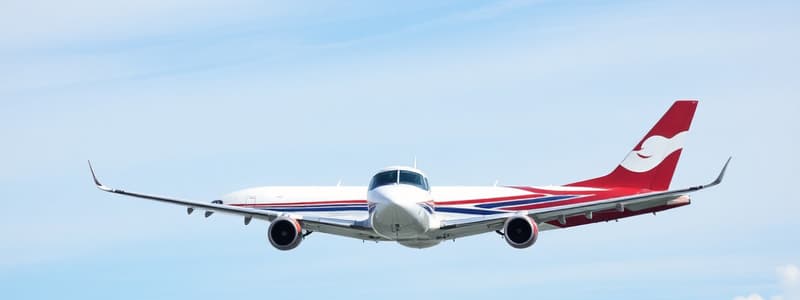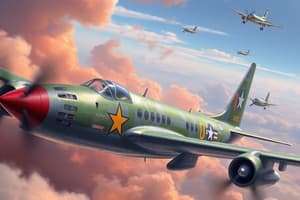Podcast
Questions and Answers
What is the purpose of assigning a heading to a departing aircraft?
What is the purpose of assigning a heading to a departing aircraft?
- To avoid conflict with other aircraft.
- To ensure the aircraft can join an airway, intercept a course or radial, or navigate direct to a navaid. (correct)
- To allow the controller to track the aircraft's position more easily.
- To ensure the aircraft flies a safe and efficient route.
What is the meaning of "TR" in the written version of "Cessna niner papa uniform, turn right heading three five zero"?
What is the meaning of "TR" in the written version of "Cessna niner papa uniform, turn right heading three five zero"?
- Turn right immediately.
- Turn right to the designated heading, then join the airway.
- Turn right to the designated heading.
- Turn right heading. (correct)
What is implied by the written version "UAL611 TR 150 V97"?
What is implied by the written version "UAL611 TR 150 V97"?
- The pilot should turn right to heading 150 and then fly direct to Victor 97.
- The pilot should turn 150 degrees right and then join Victor 97.
- The pilot should fly on heading 150 until reaching Victor 97.
- The pilot should turn right to heading 150 and then join Victor 97. (correct)
What is the purpose of the phrase "cleared as filed (CAF)"?
What is the purpose of the phrase "cleared as filed (CAF)"?
Why is it essential for the controller to include the first airway in the "cleared as filed" clearance when the departure airport is not equipped with radar?
Why is it essential for the controller to include the first airway in the "cleared as filed" clearance when the departure airport is not equipped with radar?
What is the name of the navaid that Kingair three papa uniform is to fly direct to?
What is the name of the navaid that Kingair three papa uniform is to fly direct to?
What does the phrase "fly heading" indicate in the written instructions?
What does the phrase "fly heading" indicate in the written instructions?
In the context of the given information, what does "IFR" stand for?
In the context of the given information, what does "IFR" stand for?
What is the main purpose of a 'Route of Flight' as described in this text?
What is the main purpose of a 'Route of Flight' as described in this text?
What is the primary reason for using radar coverage to verify the aircraft's actual route of flight?
What is the primary reason for using radar coverage to verify the aircraft's actual route of flight?
What is the first step when an aircraft is allowed to leave the holding fix?
What is the first step when an aircraft is allowed to leave the holding fix?
Which phrase should be used if there is no change in the route since entering the holding pattern?
Which phrase should be used if there is no change in the route since entering the holding pattern?
What does the controller's request for the pilot to 'acknowledge' imply?
What does the controller's request for the pilot to 'acknowledge' imply?
When is a pilot expected to take shortcuts after leaving the holding pattern?
When is a pilot expected to take shortcuts after leaving the holding pattern?
What altitude should be maintained after a pilot receives a clearance to leave a holding pattern?
What altitude should be maintained after a pilot receives a clearance to leave a holding pattern?
What is the significance of the term 'holding fix' in aircraft communication?
What is the significance of the term 'holding fix' in aircraft communication?
What should the pilot do as soon as they receive clearance to leave the holding pattern?
What should the pilot do as soon as they receive clearance to leave the holding pattern?
What is the recommended climb or descent rate when approaching within 1,000 feet of the assigned altitude?
What is the recommended climb or descent rate when approaching within 1,000 feet of the assigned altitude?
Which condition allows a pilot to change altitude at their discretion?
Which condition allows a pilot to change altitude at their discretion?
During altitude changes, what is prohibited when operating under pilot's discretion?
During altitude changes, what is prohibited when operating under pilot's discretion?
What must be done when instructed to cross a specified point at or below a certain altitude?
What must be done when instructed to cross a specified point at or below a certain altitude?
What is a consequence of using pilot's discretion for altitude changes?
What is a consequence of using pilot's discretion for altitude changes?
Which phraseology indicates that a pilot may begin their descent at any time?
Which phraseology indicates that a pilot may begin their descent at any time?
What is the ultimate requirement for a pilot once they engage in an altitude change with pilot's discretion?
What is the ultimate requirement for a pilot once they engage in an altitude change with pilot's discretion?
What does 'maintain flight level' imply when followed by a discretion clause?
What does 'maintain flight level' imply when followed by a discretion clause?
What is a critical aspect pilots must remember when utilizing pilot's discretion in altitude changes?
What is a critical aspect pilots must remember when utilizing pilot's discretion in altitude changes?
When crossing a designated point under altitude restrictions, what is paramount?
When crossing a designated point under altitude restrictions, what is paramount?
What does an option clearance authorize the pilot to do?
What does an option clearance authorize the pilot to do?
Which statement correctly describes an ILS approach clearance?
Which statement correctly describes an ILS approach clearance?
What are the minimum components required in an IFR clearance?
What are the minimum components required in an IFR clearance?
What does the term 'cleared for approach' signify?
What does the term 'cleared for approach' signify?
In the context of IFR clearances, which item is NOT always required?
In the context of IFR clearances, which item is NOT always required?
What is the primary purpose of an option clearance for student pilots?
What is the primary purpose of an option clearance for student pilots?
Which of the following best describes the clearance for 'King Air four papa uniform'?
Which of the following best describes the clearance for 'King Air four papa uniform'?
What is a responsibility of the pilot concerning option clearances during flight training?
What is a responsibility of the pilot concerning option clearances during flight training?
In the provided context, which type of clearance is issued to ensure pilots report passing through a specific altitude, but not reaching it?
In the provided context, which type of clearance is issued to ensure pilots report passing through a specific altitude, but not reaching it?
What is the primary purpose of a holding pattern, as described in the text?
What is the primary purpose of a holding pattern, as described in the text?
Which of the following is NOT a typical component of a holding instruction?
Which of the following is NOT a typical component of a holding instruction?
What does the phrase "N16E c 70 RR" likely indicate in the first example provided in the text?
What does the phrase "N16E c 70 RR" likely indicate in the first example provided in the text?
Based on the example "Lear seven golf juliett, descend and maintain six thousand, report leaving flight level one niner zero, report leaving one one thousand (N7GJ T 60 RL190 RL 110)", what altitude is the aircraft expected to descend to?
Based on the example "Lear seven golf juliett, descend and maintain six thousand, report leaving flight level one niner zero, report leaving one one thousand (N7GJ T 60 RL190 RL 110)", what altitude is the aircraft expected to descend to?
Which phraseology element is specifically used to inform the pilot about the direction of holding in a holding instruction?
Which phraseology element is specifically used to inform the pilot about the direction of holding in a holding instruction?
Based on the text, which of the following statements about holding patterns is MOST accurate?
Based on the text, which of the following statements about holding patterns is MOST accurate?
According to FAR 91, a pilot is required to inform the controller about which of the following events?
According to FAR 91, a pilot is required to inform the controller about which of the following events?
What is the primary purpose of reporting "reaching" an assigned altitude, as described in the text?
What is the primary purpose of reporting "reaching" an assigned altitude, as described in the text?
Imagine an aircraft is cleared to "descend and maintain six thousand, report leaving flight level one niner zero, report leaving one one thousand". Based on the text, what does this mean?
Imagine an aircraft is cleared to "descend and maintain six thousand, report leaving flight level one niner zero, report leaving one one thousand". Based on the text, what does this mean?
Flashcards are hidden until you start studying
Study Notes
Aircraft Phraseology and Identification
- Option clearances allow pilots to land, perform touch-and-go, stop-and-go, or low approaches. Pilots don't have to inform the controller of the specific maneuver.
- ILS clearances authorize instrument approaches via the indicated Instrument Landing System (ILS) procedure.
- "Cleared for approach" enables any instrument approach procedure at a defined airport.
- IFR clearances, used before departure, always include aircraft identification, "cleared," clearance limit, departure instructions, route of flight, altitude, holding instructions (where necessary), and frequency/transponder information.
- Aircraft identification uses standard procedures. Clear, concise identification is paramount for preventing misdirected instructions and ensuring the controller knows the correct aircraft.
Airline Identification
- Scheduled airline flights (FAR 121 or 125) are identified by the airline name followed by the flight number.
- Every airline flight is assigned a three-letter designator and a flight number; these are pronounced together.
- Airline names are chosen to avoid confusion and are easily recognizable.
- In written communication, the three-letter designator is used.
- General aviation aircraft are identified by the aircraft type and a unique FAA-assigned serial number.
General Aviation Aircraft Call Signals
- FAA-approved general aviation aircraft call signs consist of an aircraft type and a unique serial number, containing 5 numbers or letters, which are annunciated individually.
- The letter N precedes the serial number for aircraft registered in the United States.
- Aircraft in other countries have identification numbers or letters with a prefix other than N.
- Similar last three characters in aircraft serial numbers should be annunciated fully.
Military Aircraft Call Signals
- Military aircraft have various call signs, including five numbers, one word followed by numbers, or two letters followed by numbers.
- Call signs always include the military service (e.g., Army, Navy, Air Force).
- Example call sign prefixes include USAF, US Coast Guard, Canadian Armed Forces, Canadian Coast Guard.
Presidential Aircraft Call Signals
- Presidential aircraft have specific call signs, generally including the military service (e.g., Air Force One).
- Aircraft carrying the Vice President have a similar designation, but with "two" instead of "one."
- Family members of the president or vice president on an aircraft will be appended by 'F'
Departure Instructions
- IFR aircraft should be cleared with an initial route to the intended heading or a published SID route.
- Turn instructions (e.g., turn right heading, turn left heading, or fly heading) are given in advance.
- The pilot should follow instructions to turn right or left unless otherwise specified given the optimal turn.
- If an altitude is assigned, the pilot is expected to climb or descend at a reasonable pace.
- In some cases, the pilot has discretion over when to climb or descend.
Destination and Intermediate Fixes
- Clearances should ideally be issued to the pilot's defined destination airport.
- If inability to land at destination airport occurs, intermediate fixes and expected routes are identified with an expected hold time, if applicable.
Altitude Assignments
- IFR and VFR pilots are given altitudes; IFR pilots must follow altitudes.
- Flight path deviations or changes in altitude are dependent on conditions.
Holding Instructions
- If dictated, pilots must follow holding pattern instructions issued for the inbound route from assigned or filed destination.
- Leg length in miles, and turn specifications are issued.
- Expected departure time is also included where appropriate.
Report Crossing
- Pilots are required to report when they cross a specific intersection or fix.
- Pilots are required to report reaching a specified altitude.
- Pilots may be required to report when leaving a specific intermediate altitude
- FAA requirements require the pilot to report leaving a specific altitude unless otherwise noted.
Additional Communications and Phraseology
- The phrase 'acknowledge' instructs the pilot to verify the message.
- 'Confirmative' and 'negative' are used for verification.
- A pilot may be required to 'say intentions' upon completing a maneuver.
- The 'expect' instruction informs the pilot ahead of future instructions or changes.
- The use of FAA standardized phrases and abbreviations reduces miscommunication.
Studying That Suits You
Use AI to generate personalized quizzes and flashcards to suit your learning preferences.




